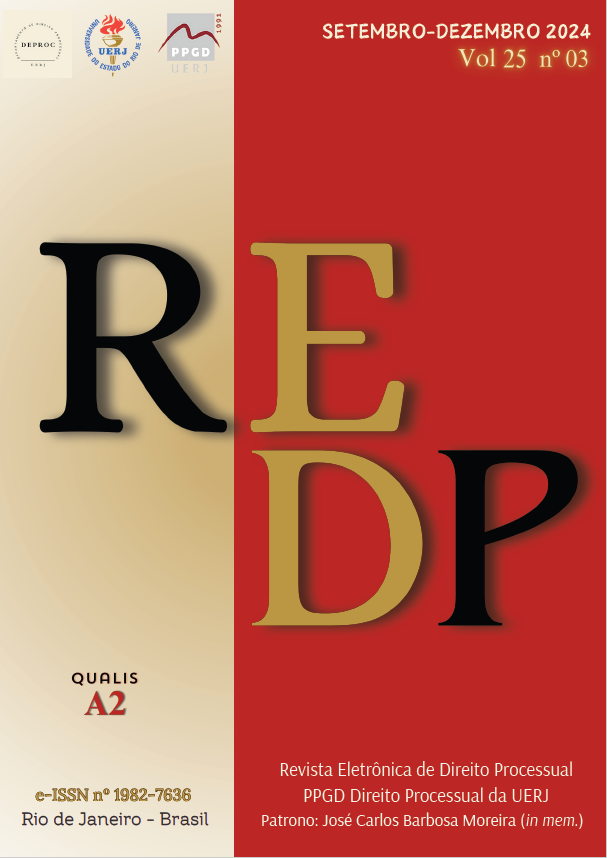O OBJETIVO DE DESENVOLVIMENTO SUSTÁVEL (ODS) 16 (PAZ, JUSTIÇA E INSTITUIÇÕES EFICAZES) E A RESOLUÇÃO 125/2010 DO CONSELHO NACIONAL DE JUSTIÇA (CNJ) ENQUANTO POLÍTICA JUDICIÁRIA BRASILEIRA DE ACESSO À JUSTIÇA
DOI:
https://doi.org/10.12957/redp.2024.86612Resumo
A Organização das Nações Unidas (ONU) instituiu, em 2015, 17 Objetivos de Desenvolvimento Sustentável (ODS) com o intuito de superar alguns dos grandes desafios mundiais da atualidade. Esses objetivos formaram a “Agenda 2030” que compromissou os países integrantes da Cúpula das Nações Unidas sobre o Desenvolvimento Sustentável. A Agenda 2030 se transformou na principal referência quanto a formulação e implementação de políticas públicas para governos ao redor do mundo.O presente texto aborda o acesso à justiça no Brasil partindo da autocomposição (mediação e conciliação) que é mecanismo de resolução de conflitos previsto na Resolução 125/2010 do CNJ. O problema norteador da presente pesquisa questiona: a Resolução 125/2010 do CNJ é política judiciária brasileira de acesso à justiça, oferecendo mecanismos de implementação e cumprimento do ODS 16 (Paz, Justiça e Instituições Eficazes), especialmente quando a meta 16.3 (promover o Estado de Direito e garantir a igualdade de acesso à justiça)? Para fins de responder ao problema de pesquisa o método de abordagem utilizado foi o dedutivo. Como método de procedimento utilizou-se o método monográfico, objetivando analisar a Resolução 125/2010 do CNJ enquanto política judiciária brasileira de acesso à justiça que oferece mecanismos de implementação e cumprimento do ODS 16 (Paz, Justiça e Instituições Eficazes), especialmente quando a meta 16.3. Ao final, conclui-se, que a Resolução 125/2010 do CNJ é uma política judiciária nacional que objetiva proporcionar o acesso à justiça pela prática de mecanismos autocompositivos de resolução de conflitos, observando o ODS 16 e sua meta 16.3. Porém para que seja possível afirmar que a Resolução 125 vem cumprindo com o ODS 16, meta 16.3, faz-se necessário avaliá-la e essa é uma fragilidade significativa uma vez que se observa que a avaliação não existe de forma sistemática, e que o formato aplicado, por tempo exíguo, não permite uma adequada participação social.
Downloads
Publicado
Como Citar
Edição
Seção
Licença
Copyright (c) 2024 Fabiana Marion Spengler

Este trabalho está licenciado sob uma licença Creative Commons Attribution 4.0 International License.
Todos os artigos publicados na Revista Eletrônica de Direito Processual (REDP) (Departamento de Direito Processual, Universidade do Estado do Rio de Janeiro, Brasil) são licenciados por meio de uma Licença Creative Commons - Atribuição 4.0 Internacional (CC BY 4.0).
Os autores retêm os direitos autorais de seu artigo e concordam em licenciar seu trabalho com a licença CC BY 4.0, aceitando assim os termos e condições específicos desta licença disponíveis no seguinte website: https://creativecommons.org/licenses/by/4.0/legalcode.
- Os autores concedem à REDP o direito de primeira publicação, de se identificar como publicadora original do trabalho e concedem à revista uma licença de direitos não exclusivos para utilizar o trabalho das seguintes formas: Reproduzir, vender e distribuir cópias eletrônicas ou impressas do manuscrito como um todo, de partes específicas do manuscrito e de suas traduções para qualquer idioma;
- O uso do artigo por terceiros é livre, contanto que a integridade da publicação seja mantida e seus autores originais, periódico de primeira publicação e detalhes de citação sejam identificados.
Dentro dos termos da licença, os autores podem entrar em acordos contratuais adicionais separados para a distribuição não exclusiva da versão publicada do trabalho na revista.
Copyright and Licensing
All articles published in the Procedural Law Electronic Review (REDP) (Department of Procedural Law, State University of Rio de Janeiro, Brazil) are licensed under a Creative Commons License - Attribution 4.0 International (CC BY 4.0).
- Authors retain copyright to their article and agree to license their work under the CC BY 4.0 license, thereby accepting the specific terms and conditions of this license available at the following website: https://creativecommons.org/licenses/by/4.0/ legal code.
- Authors grant REDP the right of first publication, to identify itself as the original publisher of the work, and grant the journal a non-exclusive license to use the work in the following ways: Reproduce, sell and distribute electronic or printed copies of the manuscript as a whole, of specific parts of the manuscript and its translations into any language;
- Use of the article by third parties is free, as long as the integrity of the publication is maintained and its original authors, first publication journal, and citation details are identified.
Within the terms of the license, authors may enter into separate additional contractual agreements for the non-exclusive distribution of the published version of the work in the journal.




